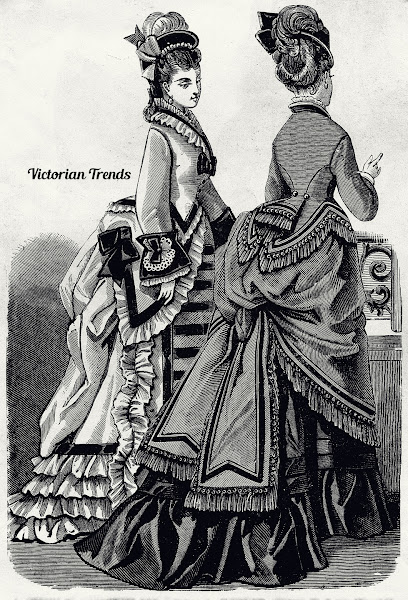First-generation digital scan of an engraved fashion plate (in full color) from the January 1860 issue of Godey's Lady's Book in my personal collection. The description from the book reads as follows:
The Bride's Toilet. -- Gored dress of thick white silk, sloped to the hips, the only ornament being flat bows of white satin ribbon, fastened by pearl buckles in the centre; these extend from the throat to the hem of the skirt. Veil of thulle. Wreath, mounted in the coronet form, of fine flowers, jessamine, and rose-buds.
From left to right:
Fig. 1. -- Dress of queen's purple moire; the skirt full and plain, ornamented by a tablier trimmed of black Chantilly lace, placed spirally on each side of the front breadth, and following the opening of the corsage around the throat. From the waist line to the hem of the skirt is placed a row of rosettes of silk and lace. Sleeves, quite tight at the shoulder, and widening a little to the parement or turned back cuff. Undersleeves and chemisette of point lace. Bonnet of white therry velvet with white plumes.
Fig. 2. -- Dress of steel blue and black Bayadere stripes on a white ground, suited, at this season, only at dinner, evening, or dress receptions. The sleeve is new, and extremely pretty; corsage plain, and in double points at the waist. Bonnet of white crape, with wreaths of bluish roses outside and in; strings of rose-colored ribbon.
Fig. 3. -- Dress of Azof green moire, made en surplis, or tending decidedly to one side, in the arrangement of the trimming, which consists of lappet ornaments in black lace; corsage open after the style of a vest, or en gilet.
Fig. 4. -- Robe or pattern dress, of steel blue silk, with a border and tablier front of velvet, a light shade of groseille, with a raised figure in black, and tassels of groseille at the end of each bar. The sleeves are quite tight, with caps and cuffs of the velvet. Bonnet of white crape. Clotilde veil of blonde.

All digitized work by Victorian Trends.com is licensed under a
Creative Commons Attribution-NonCommercial 4.0 International License.
Free for personal use only. Please link back to VictorianTrends.com as your source when sharing or publishing.

















